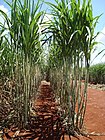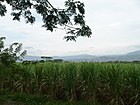Note: This is a project under development. The articles on this wiki are just being initiated and broadly incomplete. You can Help creating new pages.
Saccharum Officinarum - Sugarcane
Saccharum Officinarum is a large perennial grass. It produces thick culms that may grow up to 2 - 3 meters tall. A major crop in the tropics, where it is grown mainly for the sap in the stems which is used for making sugar, alcohol for fuel etc.[1]
Contents
- 1 Uses
- 2 Parts Used
- 3 Chemical Composition
- 4 Common names
- 5 Properties
- 6 Habit
- 7 Identification
- 8 List of Ayurvedic medicine in which the herb is used
- 9 Where to get the saplings
- 10 Mode of Propagation
- 11 How to plant/cultivate
- 12 Commonly seen growing in areas
- 13 Photo Gallery
- 14 References
- 15 External Links
Uses
Piles, Headache, Indigestion, Kidney Stone, Diabetes, Jaundice, Headache, Indigestion[1].
Parts Used
Chemical Composition
Common names
| Language | Common name |
|---|---|
| Kannada | Rasadaali Kabbu, Kempu kabbu |
| Hindi | Ganna |
| Malayalam | NA |
| Tamil | Ikku, Karambu |
| Telugu | Cheraku, Kantaramu |
| Marathi | NA |
| Gujarathi | |
| Punjabi | NA |
| Kashmiri | NA |
| Sanskrit | Rasaala, Gudadaaru |
| English | Shugercane |
Properties
Reference: Dravya - Substance, Rasa - Taste, Guna - Qualities, Veerya - Potency, Vipaka - Post-digesion effect, Karma - Pharmacological activity, Prabhava - Therepeutics.
Dravya
Rasa
Guna
Veerya
Vipaka
Karma
Prabhava
Habit
Identification
Leaf
| Kind | Shape | Feature |
|---|---|---|
Flower
| Type | Size | Color and composition | Stamen | More information |
|---|---|---|---|---|
| Flowering season is December to April |
Fruit
| Type | Size | Mass | Appearance | Seeds | More information |
|---|---|---|---|---|---|
| Fruiting season is December to April |
Other features
List of Ayurvedic medicine in which the herb is used
Amritapaasha Gritha, Sitophalaadi Churna, Sukumara Gritha, Sukumara Rasayana[1]
Where to get the saplings
Mode of Propagation
How to plant/cultivate
Grows best in a sunny position. A very greedy plant, soon exhausting the soil of nutrients. The plant is considered to be moderately tolerant to saline soil conditions and relatively tolerant of acid soils. Grows best in a position sheltered from strong winds. Prefers a pH in the range 5 - 8, but can tolerate 4.5 - 9. Well-grown plants can become invasive.[4]
Commonly seen growing in areas
[[:Category:Herbs that are commonly seen in the region of |]], [[:Category:Herbs that are commonly seen in the region of |]], [[:Category:Herbs that are commonly seen in the region of |]], [[:Category:Herbs that are commonly seen in the region of |]], [[:Category:Herbs that are commonly seen in the region of |]].
Photo Gallery
References
External Links
- Pages using duplicate arguments in template calls
- Ayurvedic Herbs known to be helpful to treat Piles
- Ayurvedic Herbs known to be helpful to treat Headache
- Ayurvedic Herbs known to be helpful to treat Indigestion
- Ayurvedic Herbs known to be helpful to treat Kidney Stone
- Ayurvedic Herbs known to be helpful to treat Diabetes
- Ayurvedic Herbs known to be helpful to treat Jaundice
- Herbs with Root used in medicine
- Herbs with Suger used in medicine
- Herbs with common name in Kannada
- Herbs with common name in Hindi
- Herbs with common name in Tamil
- Herbs with common name in Telugu
- Herbs with common name in Sanskrit
- Herbs with common name in English
- Habit - Perennial
- Index of Plants which can be propagated by Seed
- Index of Plants which can be propagated by Cuttings
- Herbs that are commonly seen in the region of
- Ayurvedic Medicine
- Pages without herbs images





